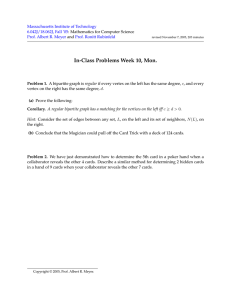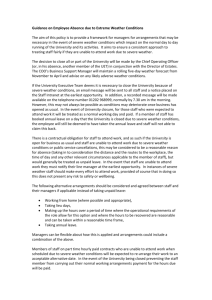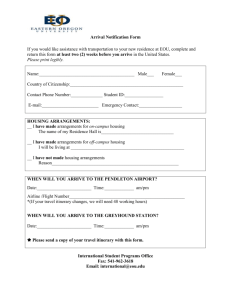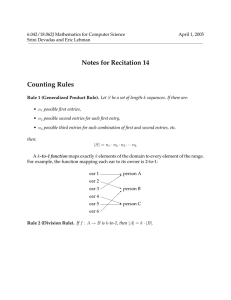In-Class
advertisement
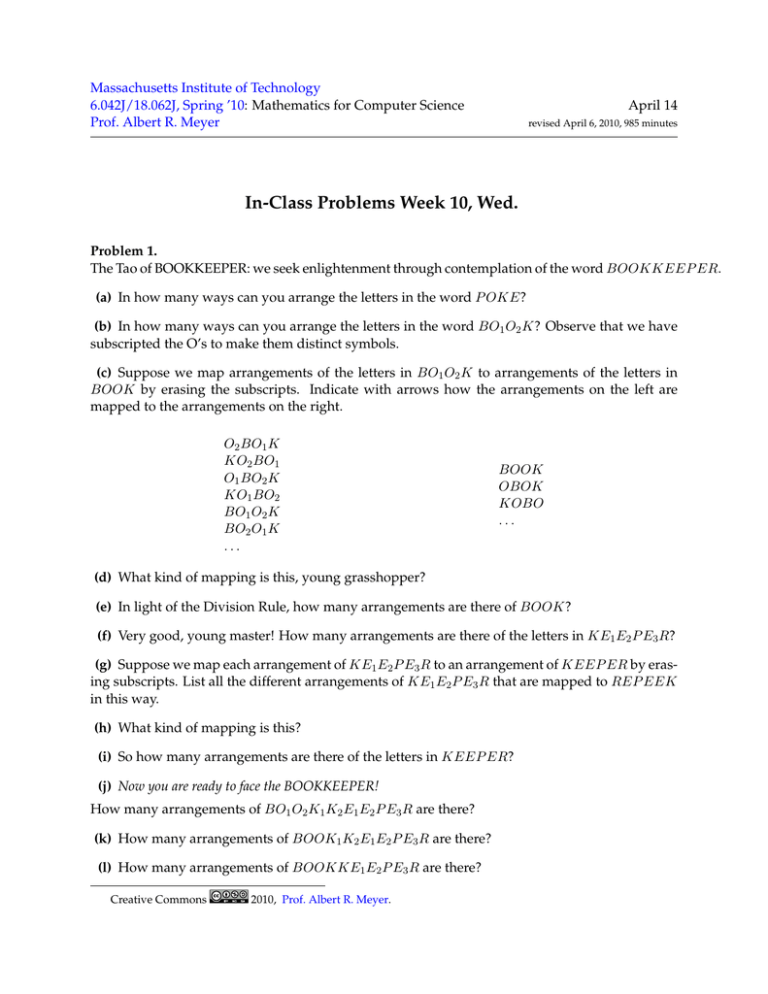
Massachusetts Institute of Technology 6.042J/18.062J, Spring ’10: Mathematics for Computer Science Prof. Albert R. Meyer April 14 revised April 6, 2010, 985 minutes In-Class Problems Week 10, Wed. Problem 1. The Tao of BOOKKEEPER: we seek enlightenment through contemplation of the word BOOKKEEP ER. (a) In how many ways can you arrange the letters in the word P OKE? (b) In how many ways can you arrange the letters in the word BO1 O2 K? Observe that we have subscripted the O’s to make them distinct symbols. (c) Suppose we map arrangements of the letters in BO1 O2 K to arrangements of the letters in BOOK by erasing the subscripts. Indicate with arrows how the arrangements on the left are mapped to the arrangements on the right. O2 BO1 K KO2 BO1 O1 BO2 K KO1 BO2 BO1 O2 K BO2 O1 K . . . BOOK OBOK KOBO ... (d) What kind of mapping is this, young grasshopper? (e) In light of the Division Rule, how many arrangements are there of BOOK? (f) Very good, young master! How many arrangements are there of the letters in KE1 E2 P E3 R? (g) Suppose we map each arrangement of KE1 E2 P E3 R to an arrangement of KEEP ER by eras­ ing subscripts. List all the different arrangements of KE1 E2 P E3 R that are mapped to REP EEK in this way. (h) What kind of mapping is this? (i) So how many arrangements are there of the letters in KEEP ER? (j) Now you are ready to face the BOOKKEEPER! How many arrangements of BO1 O2 K1 K2 E1 E2 P E3 R are there? (k) How many arrangements of BOOK1 K2 E1 E2 P E3 R are there? (l) How many arrangements of BOOKKE1 E2 P E3 R are there? Creative Commons 2010, Prof. Albert R. Meyer. 2 In-Class Problems Week 10, Wed. (m) How many arrangements of BOOKKEEP ER are there? Remember well what you have learned: subscripts on, subscripts off. This is the Tao of Bookkeeper. (n) How many arrangements of V OODOODOLL are there? (o) How many length 52 sequences of digits contain exactly 17 two’s, 23 fives, and 12 nines? Problem 2. (a) Show that the Magician could not pull off the trick with a deck larger than 124 cards. Hint: Compare the number of 5-card hands in an n-card deck with the number of 4-card sequences. (b) Show that, in principle, the Magician could pull off the Card Trick with a deck of 124 cards. Hint: Hall’s Theorem and degree-constrained (10.6.5) graphs. Problem 3. The Magician can determine the 5th card in a poker hand when his Assisant reveals the other 4 cards. Describe a similar method for determining 2 hidden cards in a hand of 9 cards when your Assisant reveals the other 7 cards. Problem 4. Solve the following counting problems. Define an appropriate mapping (bijective or k-to-1) be­ tween a set whose size you know and the set in question. (a) An independent living group is hosting nine new candidates for membership. Each candidate must be assigned a task: 1 must wash pots, 2 must clean the kitchen, 3 must clean the bathrooms, 1 must clean the common area, and 2 must serve dinner. Write a multinomial coefficient for the number of ways this can be done. (b) Write a multinomial coefficient for the number of nonnegative integer solutions for the equa­ tion: x1 + x2 + x3 + x4 + x5 = 8. (1) (c) How many nonnegative integers less than 1,000,000 have exactly one digit equal to 9 and have a sum of digits equal to 17? MIT OpenCourseWare http://ocw.mit.edu 6.042J / 18.062J Mathematics for Computer Science Spring 2010 For information about citing these materials or our Terms of Use, visit: http://ocw.mit.edu/terms.
